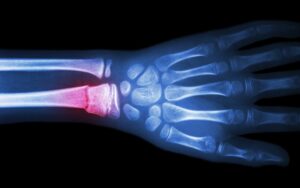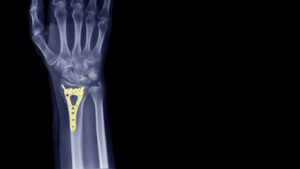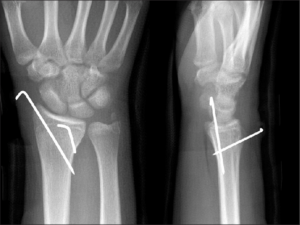Distal Radius Fracture Protocols
-
Closed Reduction (no surgery)
-
Open Reduction Internal Fixation (ORIF)
-
Percutaneous Pinning

- Basic terminology
- Active range of motion (AROM) - effective appendage moves independently without assistance.
- Passive range of motion (PROM) - effective appendage moves only with assistance, in other words the left index finger does not work, it is stretched only with the assistance of the right hand.
- 10-14 Days Post Injury
- Active and Passive range of motion to be performed for the following:
- Thumb and digits
- Elbow (if not casted)
- Forearm
- Shoulder
- 10 minute sessions - 6 times a day
- Active and Passive range of motion to be performed for the following:
- 6 Weeks Post Injury
- Physician must determine that bone has healed sufficiently and cast is removed.
- Removable wrist splint is provided. (Wear between exercise sessions and at night)
- Edema control - compression sleeves or gloves if needed.
- Begin performing AROM exercises for the wrist.
- Continue AROM/PROM for the elbow, forearm, thumb, digits.
- 8 Weeks Post Injury
- Decrease wear time with splint.
- Begin PROM exercises to the wrist and forearm each hour for 10 minute sessions. (Surgeon must approve PROM to be initiated first- sometimes this is OK at 6 weeks if surgeon approves).
- Progressive strengthening begins for wrist and hand. 1-2 lbs weights for eccentric wrist strengthening activities.
- Considerations
- You will be very tight starting out. TENS units are very helpful with pain. The more you stretch, the easier your recovery time will be. Do NOT try to strengthen before 8 weeks unless approved by your surgeon!! Strengthening involves anything that requires force or that applies resistance to the hand or wrist. When performing stretches, the hardest you should go is to around a flinch level (or a 5/10).
- Don't push yourself through agonizing pain (pain scale of 9/10) because it will slow your progress! Your bone tissue does not care how tough you are, it will re-fracture if you push it too hard before these timelines (or before your doctor tells you it's ok).
- COMMUNICATE with your surgeon and don't miss your appointments.

- Basic terminology
- Active range of motion (AROM) - effective appendage moves independently without assistance.
- Passive range of motion (PROM) - effective appendage moves only with assistance, in other words the left index finger does not work, it is stretched only with the assistance of the right hand.
- 10-14 Days Post Injury
- Active and Passive range of motion to be performed for the following:
- Thumb and digits
- Wrist (Gentle AROM - clear with doctor first!)
- Elbow (if not casted)
- Forearm
- Shoulder
- 10 minute sessions - 6 times a day
- Edema control - compression sleeves or gloves if needed.
- Active and Passive range of motion to be performed for the following:
- 6 Weeks Post Injury
- Physician must determine that bone has healed sufficiently and cast is removed.
- Wear orthotic between exercise sessions and at night.
- Edema control - compression sleeves or gloves if needed.
- Begin performing PROM exercises for the wrist.
- Continue AROM/PROM for the elbow, forearm, thumb, digits.
- 8 Weeks Post Injury
- Gradually decrease wear time with splint.
- Continue PROM to the wrist and forearm, may be more aggressive at this point (get Dr. approval first!)
- Progressive strengthening begins for wrist and hand. 1-2 lbs weights for eccentric wrist strengthening activities.
- Considerations
- You will be very tight starting out. TENS units are very helpful with pain. The more you stretch, the easier your recovery time will be. Do NOT try to strengthen before 8 weeks unless approved by your surgeon!! Strengthening involves anything that requires force or that applies resistance to the hand or wrist. When performing stretches, the hardest you should go is to around a flinch level (or a 5/10).
- Don't push yourself through severe pain (pain scale of 9/10) because it will slow your progress! Your bone tissue does not care how tough you are, it will re-fracture if you push it too hard before these timelines (or before your doctor tells you it's ok).
- COMMUNICATE with your surgeon and don't miss your appointments.

- Basic terminology
- Active range of motion (AROM) - effective appendage moves independently without assistance.
- Passive range of motion (PROM) - effective appendage moves only with assistance, in other words the left index finger does not work, it is stretched only with the assistance of the right hand.
- 10-14 Days Post Injury
- Active and Passive range of motion to be performed for the following:
- Thumb and digits
- Elbow (if not casted)
- Forearm
- Shoulder
- 10 minute sessions - 6 times a day
- Active and Passive range of motion to be performed for the following:
- 6 Weeks Post Injury
- Physician must determine that bone has healed sufficiently and cast is removed.
- Removable wrist splint is provided. (Wear between exercise sessions and at night)
- Edema control - compression sleeves or gloves if needed.
- Begin performing AROM exercises for the wrist.
- Continue AROM/PROM for the elbow, forearm, thumb, digits.
- 8 Weeks Post Injury
- Decrease wear time with splint.
- Begin PROM exercises to the wrist and forearm each hour for 10 minute sessions. (Surgeon must approve PROM to be initiated first- sometimes this is OK at 6 weeks if surgeon approves).
- Progressive strengthening begins for wrist and hand. 1-2 lbs weights for eccentric wrist strengthening activities.
- Considerations
- You will be very tight starting out. TENS units are very helpful with pain. The more you stretch, the easier your recovery time will be. Do NOT try to strengthen before 8 weeks unless approved by your surgeon!! Strengthening involves anything that requires force or that applies resistance to the hand or wrist. When performing stretches, the hardest you should go is to around a flinch level (or a 5/10).
- Don't push yourself through agonizing pain (pain scale of 9/10) because it will slow your progress! Your bone tissue does not care how tough you are, it will re-fracture if you push it too hard before these timelines (or before your doctor tells you it's ok).
- COMMUNICATE with your surgeon and don't miss your appointments.
Exercises
Distal Radius Fracture Exercises
-
Closed Reduction (No surgery)
Week 1-5
Access Code: A846HTLC
CLICK HERE to go to the home exercise program! Enter the Access Code: A846HTLC
Exercises
- Seated Finger Composite Flexion Stretch - 6 x daily - 7 x weekly - 1 sets - 10 reps - 5 seconds hold
- Seated Finger Composite Flexion Extension - 6 x daily - 7 x weekly - 1 sets - 10 reps
- Seated Composite Thumb Flexion PROM - 6 x daily - 7 x weekly - 1 sets - 10 reps - 5 seconds hold
- Seated Composite Thumb Flexion AROM - 6 x daily - 7 x weekly - 1 sets - 10 reps
- Seated Elbow Flexion and Extension AROM - 6 x daily - 7 x weekly - 1 sets - 10 reps
- Supported Elbow Flexion Extension PROM - 6 x daily - 7 x weekly - 1 sets - 10 reps
- Supine Shoulder Flexion Extension Full Range AROM - 6 x daily - 7 x weekly - 1 sets - 10 reps
- Shoulder External and Internal Rotation AROM - 6 x daily - 7 x weekly - 1 sets - 10 reps
Week 6 - 7
Copy This Access Code: XFZFZNAG
CLICK HERE to access the home exercise program!
Exercises
- Wrist Prayer Stretch - 6 x daily - 7 x weekly - 1 sets - 10 reps - 5-10 seconds hold
- Seated Wrist Flexion Active Stretch Pronated with Elbow Straight - 6 x daily - 7 x weekly - 1 sets - 10 reps - 5-10 seconds hold
- Seated Wrist Supination PROM - 6 x daily - 7 x weekly - 1 sets - 10 reps - 5-10 seconds hold
- Hand AROM Tendon Gliding Series - 6 x daily - 7 x weekly - 1 sets - 10 reps
- Seated Single Digit Intrinsic Stretch - 6 x daily - 7 x weekly - 1 sets - 10 reps - 5 second hold
- Seated Finger Composite Flexion Stretch - 6 x daily - 7 x weekly - 1 sets - 10 reps - 5 sec hold
8 Weeks Post Injury (Strengthening)
Copy this Access Code: 6QHTBHGE
CLICK HERE to access the home exercise program!
